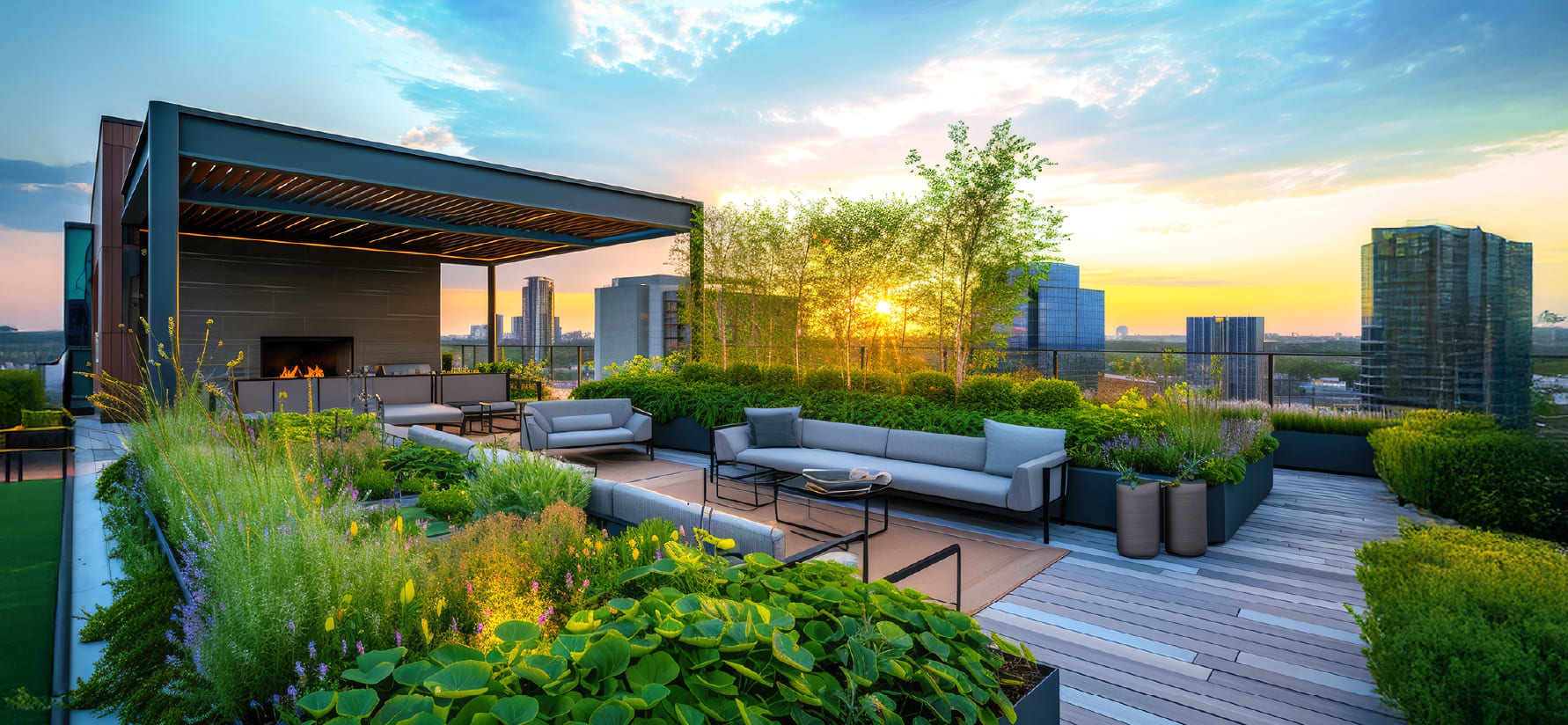Imagine stepping onto your terrace and being greeted by a burst of greenery—vibrant flowers swaying in the breeze, fresh herbs waiting to be picked, and a soothing atmosphere that instantly washes away the stress of the day. A terrace garden is a personal retreat, a space where nature and home come together to create a peaceful escape.
With cities becoming more crowded and green spaces disappearing, terrace gardening in India is an excellent way to bring nature closer to home. The advantages of terrace gardening go beyond beauty—it helps purify the air, keeps your home cooler, and lets you grow your own fresh produce. Whether you have a large open terrace or a small rooftop space, there’s potential to create something truly special.
If you’re wondering how to start a terrace garden, you’re in the right place. This guide will take you through all the essentials—from checking structural safety to picking the right plants, managing irrigation, and designing a space that reflects your style. With the right approach, you can transform any rooftop into a thriving, green oasis.
Structural Strength & Waterproofing
Before setting up your terrace garden, the first step is ensuring your rooftop can handle the added weight of soil, pots, and plants. A poorly planned setup can lead to water leakage, structural damage, and safety concerns.
Check Load-Bearing Capacity
A terrace garden can add 100–200 kg per square meter, depending on the type of soil and planters used. If you’re planning a large-scale setup, consult a structural engineer to assess weight distribution and prevent stress on the building. Lightweight materials like coco peat, vermiculite, and fiber pots help reduce the load.
Waterproofing is Essential
Water seepage is one of the biggest challenges of creating a rooftop garden. Without proper waterproofing, moisture can penetrate ceilings and walls, leading to dampness and cracks. Here’s how to protect your home:
- Apply high-quality waterproof sealants on the terrace surface before adding soil.
- Use drainage mats and porous membranes to prevent water accumulation.
- Ensure the terrace has a slight slope for natural water runoff.
Efficient Drainage System
Good drainage prevents root rot and protects your structure from long-term water damage. To enhance drainage:
- Choose pots with drainage holes to allow excess water to escape.
- Layer gravel or broken bricks at the bottom of planters for better water flow.
- Consider installing a rainwater harvesting system to reuse water efficiently.
Sunlight & Layout Planning
Just like any garden, a terrace garden thrives when plants get the right amount of sunlight. Understanding how light moves across your rooftop throughout the day will help you position your plants strategically and maximize the growth of terrace garden landscaping.
Assess Sunlight Exposure
Different plants have different sunlight requirements, so observing your terrace for a few days before setting up your garden is crucial. Here’s a simple breakdown:
- Full Sun (6+ hours per day): Ideal for flowering plants like hibiscus, bougainvillea, and marigolds, as well as vegetables like tomatoes, chilies, and brinjals.
- Partial Shade (3–6 hours per day): Best for herbs like basil, mint, and coriander, along with leafy greens such as spinach and lettuce.
- Full Shade (<3 hours per day): Suitable for indoor-friendly plants like ferns, snake plants, and peace lilies that don’t require direct sunlight.
Optimize Your Layout
Once you’ve identified how sunlight moves across your terrace, you can plan your terrace garden design to make the best use of available space.
- Use Vertical Space: If your terrace is small, go for hanging planters, wall-mounted pots, and trellises to grow climbing plants like money plants and ivy.
- Zoning Your Garden: Divide your space into sections—keep vegetables and herbs in the sunniest spots, flowering plants near edges where they get good airflow, and shade-loving plants under pergolas or in corners.
- Wind Protection: Strong winds, especially in high-rise buildings, can damage delicate plants. Use bamboo screens, glass panels, or green netting to shield them without blocking natural light.
Choosing the Right Plants & Soil
Picking the Right Plants for Your Terrace Garden
The key to terrace gardening for beginners is selecting low-maintenance plants that thrive in your local climate.
Best Plants for Full Sun (6+ Hours of Sunlight per Day)
- Flowering Plants: Bougainvillea, Hibiscus, Marigold, Sunflower
- Fruiting & Vegetable Plants: Tomatoes, Brinjals, Chilies, Okra
- Herbs: Lemongrass, Rosemary, Thyme
Best Plants for Partial Shade (3–6 Hours of Sunlight per Day)
- Leafy Greens: Spinach, Coriander, Mint, Lettuce
- Ornamental Plants: Snake Plant, Aloe Vera, Money Plant
- Low-Maintenance Flowers: Begonias, Peace Lilies
Best Plants for Full Shade (<3 Hours of Sunlight per Day)
- Ferns & Indoor Plants: Boston Fern, Areca Palm, ZZ Plant
- Hardy Shade Plants: Pothos, Philodendron, Bamboo Palm
Choosing the Best Soil for Terrace Gardening
Soil quality directly impacts plant health. A balanced soil mix ensures proper drainage and nutrient retention.
Ideal Soil Mix for a Terrace Garden:
- Garden Soil (40%) – Provides essential nutrients.
- Coco Peat (30%) – Retains moisture while keeping the soil lightweight.
- Compost or Organic Manure (20%) – Enriches the soil with nutrients.
- Perlite or Sand (10%) – Improves drainage and aeration.
Comfort & Décor: Creating a Relaxing Green Space
A terrace garden is more than plants. It’s about designing a space where you can relax.
- Seating: A simple bench for reading or a lounge setup for entertaining.
- Shade: Pergolas, fabric canopies, or tall plants for sun protection.
- Lighting: Solar lanterns or string lights for a cozy evening ambiance.
Build Your Own Green Escape
A well-planned terrace garden brings fresh air, homegrown produce, and a calm retreat right to your rooftop.
Start by ensuring your terrace is structurally sound and waterproof. Choose the right plants based on sunlight availability, use efficient watering methods, and design a space that suits your lifestyle. A well-maintained garden will provide fresh produce, enhance your home’s ambiance, and create a space to relax.
In cities where open spaces are limited, having a home with a terrace that supports gardening is a valuable feature. Terrace gardening ideas help make the most of available space, turning even small rooftops into productive green zones. Whether you focus on flowers, vegetables, or a quiet retreat, a thoughtfully designed garden enhances your living experience.
If you’re looking for a property that offers ample outdoor space, BeyondWalls helps homebuyers find well-designed homes with terraces suited for gardening.
Explore verified listings at BeyondWalls.com and find a home where your garden can flourish.


